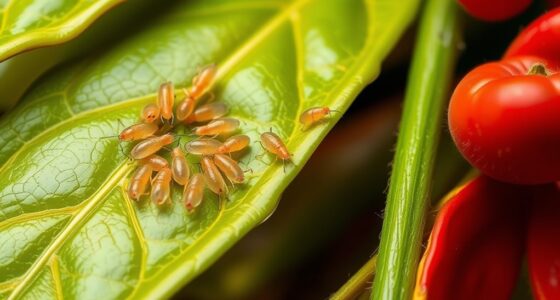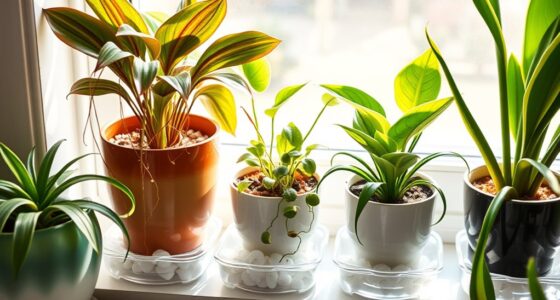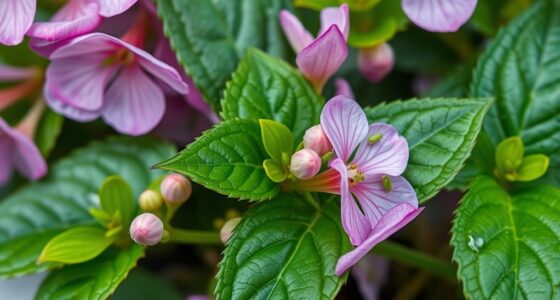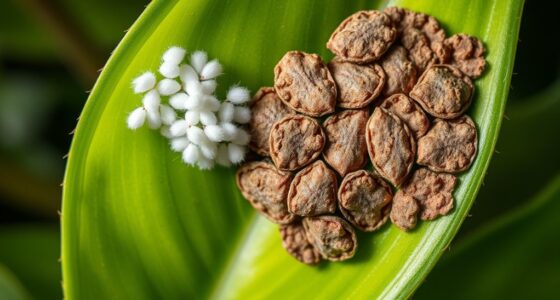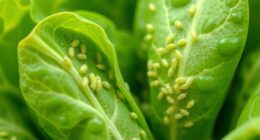Springtails in potting mix are mostly harmless and thrive in moist, organic-rich soil. Their presence often signals overwatering or excess moisture, which can lead to problems like fungal growth or root rot. While they usually don’t damage healthy plants, large populations can become a nuisance. Adjusting your watering schedule, improving drainage, and managing organic matter can help control them. Keep exploring to find out how to keep your plants healthy and springtail-free.
Key Takeaways
- Springtails are generally harmless but can become a nuisance in large populations.
- Their presence indicates overly moist soil and high organic matter, signaling improper watering.
- They do not damage healthy plants or roots directly.
- Excess moisture can promote fungal growth and root issues, indirectly affecting plant health.
- Managing watering, drainage, and soil conditions helps control springtail populations naturally.
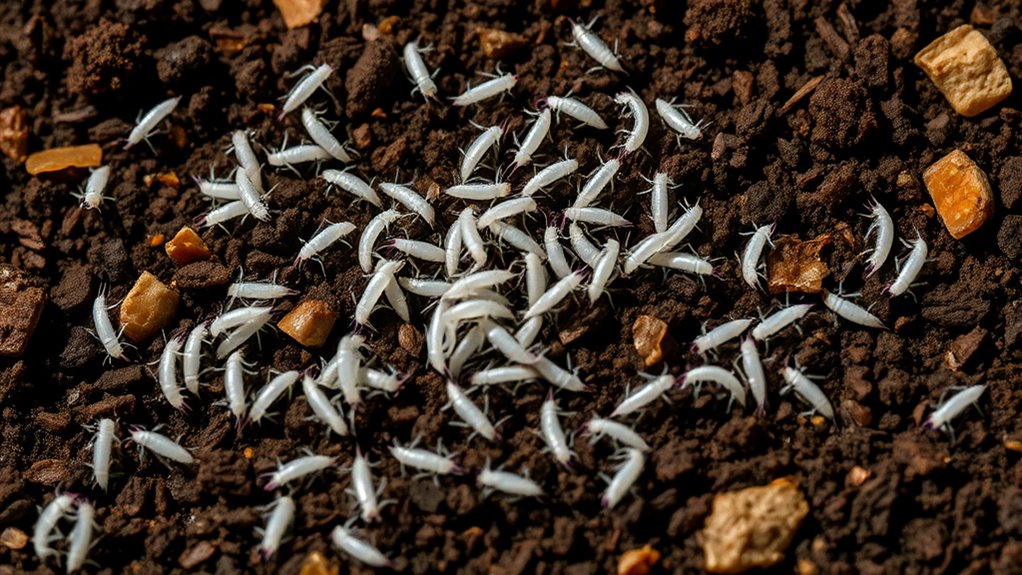
Springtails are tiny, soil-dwelling creatures that often appear in potting mix, especially in moist environments. You might notice them crawling across the surface or scurrying through the substrate, which can be startling at first. These minuscule insects thrive where there’s plenty of organic matter, which provides their primary food source. They are highly attracted to soil moisture, so if your potting mix feels damp or stays moist for long periods, you’re more likely to see them. Their presence usually indicates that the environment is rich in organic material, such as decomposed plant matter or compost, which they feed on and help break down.
Understanding their connection to soil moisture is key. Springtails flourish when your potting mix remains consistently moist, but they don’t necessarily harm healthy plants. Instead, they’re often a sign that your soil has a good amount of organic matter, which is essential for plant growth. However, if the soil stays wet for too long or if you overwater, you create ideal conditions for springtails to multiply rapidly. This can lead to a large population that might become a nuisance, especially if they start spreading to nearby plants or containers. Too much moisture can also promote other problems like mold or fungus, which can further attract these creatures.
Springtails thrive in moist soil with organic matter but can become a nuisance if overwatering occurs.
While springtails in your potting mix aren’t typically harmful to plants, their abundance can be bothersome. They don’t feed on plant roots or foliage directly, but their presence can signal overly damp conditions that might encourage root rot or fungal issues. If you notice a large number of springtails, it’s a good idea to evaluate your watering habits. Allow the soil to dry out slightly between waterings or improve drainage to reduce excess moisture. Incorporating just enough organic matter—enough to nourish your plants but not so much that it retains excess water—can help balance soil conditions and limit springtail populations. Additionally, maintaining proper soil aeration helps prevent overly compacted or waterlogged soil, limiting habitat suitability for these insects.
In most cases, springtails are more of a nuisance than a real problem. They rarely damage plants directly, but their presence can be unsettling and indicate that your potting mix’s moisture levels need adjusting. You don’t necessarily need to eliminate them entirely; instead, focus on managing soil moisture and organic matter to create an environment less inviting to these tiny creatures. Proper watering practices, good drainage, and avoiding over-fertilization will keep your potting mix healthier overall. If their numbers become overwhelming, you can take steps like drying out the soil or using natural controls, but usually, maintaining balanced moisture and organic content is enough to keep springtails in check.
Frequently Asked Questions
Are Springtails Harmful to Indoor Plants?
Springtails aren’t harmful to indoor plants, as their behavior mainly involves feeding on decaying organic matter and fungi in the soil. They don’t damage roots or leaves, so your indoor plant safety isn’t at risk. However, their presence can be a nuisance, indicating excess moisture. To keep springtails under control, reduce watering and improve drainage. This approach minimizes their activity while maintaining healthy indoor plants.
How Can I Prevent Springtails From Returning?
To keep springtails at bay, you’ll want to become a moisture control ninja. Stop overwatering and let the topsoil dry out between waterings. Also, choose your potting mix wisely—opt for well-draining, sterile options that aren’t a springtail buffet. Regularly check your plants, and if you spot them, address humidity issues promptly. With these simple steps, springtails will find your indoor garden less inviting and stay away for good.
Do Springtails Spread Plant Diseases?
Springtails generally don’t spread plant diseases, but they can signal underlying soil health issues. They thrive in moist, decaying organic matter, which can encourage other pests or pathogens. Effective pest management involves improving drainage, reducing excess moisture, and keeping your potting mix clean. By maintaining healthy soil conditions, you limit springtail populations and prevent potential problems associated with poor soil health, ensuring your plants stay healthy and pest-free.
Are Springtails Attracted to Specific Types of Potting Mix?
Yes, springtails are attracted to specific types of potting mix, especially those with high moisture levels and abundant organic matter. You’ll notice them more in damp, organic-rich soils because they thrive in moist environments and feed on decaying plant material. To reduce their presence, keep your potting mix well-drained and avoid overwatering. Proper moisture management helps deter springtails and keeps your plants healthy.
Can Springtails Survive Outside After Treatment?
Think of springtail ecology as a tiny city with thriving underground tunnels. Once treated, they won’t survive outside for long, as environmental conditions aren’t ideal. Springtails rely on moist, organic environments for outdoor survival, but exposure to sunlight, dry air, and predators quickly diminishes their chances. So, after treatment, they typically can’t endure outside, making your efforts effective in controlling their presence indoors and outdoors.
Conclusion
While springtails in potting mix might seem like a nuisance, they rarely cause real harm to your plants. Some theories suggest they actually help break down organic matter, improving soil health. So, instead of panicking, consider whether their presence indicates rich, healthy soil rather than a problem. If you notice excessive numbers or plant issues, then a gentle approach might be necessary. Otherwise, these tiny critters are more beneficial than bothersome.


